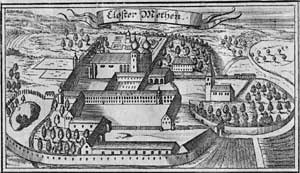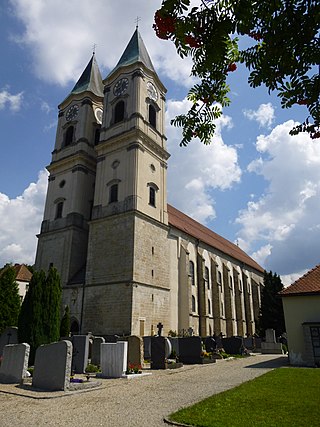
Plankstetten Abbey (Kloster Plankstetten) is a monastery of the Benedictines located between Berching and Beilngries in Bavaria, Germany. It is a member of the Bavarian Congregation of the Benedictine Confederation.

Plankstetten Abbey (Kloster Plankstetten) is a monastery of the Benedictines located between Berching and Beilngries in Bavaria, Germany. It is a member of the Bavarian Congregation of the Benedictine Confederation.
The monastery was founded in 1129 as a private monastery of the bishops of Eichstätt by Count Ernst of Hirschberg and his brother Gebhard of Hirschberg, Bishop of Eichstätt. The Romanesque crypt remains from the time of the foundation.
After the decline in monastic standards in the 15th century, the abbey was reformed by Abbot Ulrich IV Dürner (1461–94), who also founded the brewery. The abbey was badly damaged during the German Peasants' War (1525) and again in the Thirty Years' War (1618–48).
Major buildings works in the Baroque style were undertaken from the end of the 17th century. Under Abbot Romanus Dettinger (1694–1703), he created the entrance gateway with the abbot's lodging above it, the Prelates' Hall and the Banqueting Hall, as well as the corner tower on the way to the inner courtyard. The next abbot, Dominikus II Heuber (1704–11), continued the building works with the move of the sacristy and the construction of the new brewery (now the library).
Later in the century, Abbot Dominikus IV Fleischmann (1757–92) undertook the refurbishment of the abbey church. The crossing chapels are due to him; their stucco work was carried out by Johann Jakob Berg, stucco master to the court of Eichstätt. Dominikus IV was also responsible for the guesthouse opposite the main gateway.
In 1806, in the course of the secularisation of Bavaria, the monastery was dissolved and the buildings and estates auctioned off.
As early as 1856, there were plans to re-found the abbey, but these came to nothing, as the government authorities refused to give the necessary consents.
Finally, in 1904, thanks to the financial support of the Barons Cramer-Klett, Plankstetten was re-settled as a priory of Scheyern Abbey and was raised again to the status of abbey in 1917.
A school of agriculture was opened in Bavaria in 1907. It was closed by the National Socialists in 1934.
In 1958, a "Realschule" with a boarding house was opened in Bavaria. The school closed in 1988. This caused the abbey to re-examine their role and possible options, and the community now runs a training centre, a monastery shop, a farm, a nursery for plants, a butchery and a bakery, which have been organic since 1994. The boarding facilities are now used as a guesthouse.
The first Young People's Vespers took place in Plankstetten on 17 October 1980 and have since become a regular event on the third Friday in every month. They are based on the youth vespers of the Benedictine abbey at Kremsmünster in Austria and on the prayers of Taizé.
The abbey also has parish responsibilities for Plankstetten and a neighbouring village.

Ettal Abbey is a Benedictine monastery in the village of Ettal close to Oberammergau and Garmisch-Partenkirchen in Bavaria, Germany. With a community of more than 50 monks, with another five at Wechselburg, the Abbey is one of the largest Benedictine houses and is a major attraction for visitors.

Metten Abbey, or St. Michael's Abbey at Metten is a house of the Benedictine Order in Metten near Deggendorf, situated between the fringes of the Bavarian Forest and the valley of the Danube, in Bavaria in Germany.

Saint Emmeram's Abbey was a Benedictine monastery founded around 739 at Regensburg in Bavaria at the grave of the itinerant Frankish bishop Saint Emmeram. The original abbey church is now a parish church named St. Emmeram's Basilica. The other buildings on the site form a large complex known as Schloss Thurn und Taxis or Schloss St. Emmeram, which has served as the main residence of the Thurn und Taxis princely family since the early 19th century.

Tegernsee Abbey is a former Benedictine monastery in the town and district of Tegernsee in Bavaria. Both the abbey and the town that grew up around it are named after the Tegernsee, the lake on the shores of which they are located. The name is from the Old High German tegarin seo, meaning great lake.

Wessobrunn Abbey was a Benedictine monastery near Weilheim in Bavaria, Germany.

Niederaltaich Abbey is a house of the Benedictine Order founded in 741, situated in the village of Niederalteich on the Danube in Bavaria.

Benediktbeuern Abbey is an institute of the Salesians of Don Bosco, originally a monastery of the Benedictine Order, in Benediktbeuern in Bavaria, near the Kochelsee, 64 km south-south-west of Munich. It is the oldest and one of the most beautiful monasteries in Upper Bavaria. It was badly damaged in an extreme weather event in 2023.

Thierhaupten Abbey was a Benedictine monastery in Thierhaupten near the Lech River and near Augsburg in Bavaria, Germany.

Prüfening Abbey was a Benedictine monastery on the outskirts of Regensburg in Bavaria, Germany. Since the beginning of the 19th century it has also been known as Prüfening Castle. Notably, its extant dedicatory inscription, commemorating the founding of the abbey in 1119, was created by printing and is a unique document of medieval typography.

Weissenohe Abbey was a Benedictine monastery in Weissenohe in the district of Forchheim in Bavaria, Germany.

Weltenburg Abbey is a Benedictine monastery in Weltenburg near Kelheim on the Danube in Bavaria, Germany.

Weihenstephan Abbey was a Benedictine monastery in Weihenstephan, now part of the district of Freising, in Bavaria, Germany. Brauerei Weihenstephan, located at the monastery site since at least 1040, is said to be the world's oldest continuously operating brewery.
St. Stephen's Abbey, Augsburg is a Benedictine monastery, formerly a house of Augustinian canonesses, in Augsburg in Bavaria, Germany.
Münsterschwarzach Abbey, is a monastery for Benedictine monks in Germany. It is located in Schwarzach am Main, a small market town at the confluence of the rivers Schwarzach and Main in north-eastern Bavaria.

Wilhering Abbey is a Cistercian monastery in Wilhering in Upper Austria, about 8 km (5 mi) from Linz. It was founded in 1146. The buildings, re-constructed in the 18th century, are known for their spectacular Rococo decoration.

Fischingen Abbey, now Fischingen Priory, is a Benedictine monastery situated in Fischingen in the Canton of Thurgau, Switzerland, on the upper reaches of the Murg, a tributary of the Thur. It was founded in 1138, dissolved in 1848 and re-founded as a priory in 1977.

Břevnov Monastery is a Benedictine archabbey in the Břevnov district of Prague, Czech Republic. It was founded by Saint Adalbert, the second Bishop of Prague, in 993 AD with the support of Bohemian Duke Boleslaus II. The first Benedictine male monastery in Bohemia, it also has the oldest tradition of beer brewing in the Czech Republic. Brewing was interrupted several times in the history, but up to today, the Břevnov Monastery Brewery brew its beer here.

Windberg Abbey is a Premonstratensian monastery in Windberg in Lower Bavaria, Germany.

Holzen Abbey was a convent of Benedictine nuns situated in the village of Holzen in Allmannshofen in Bavaria, Germany.

Fürstenzell Abbey is a former Cistercian abbey in Fürstenzell, in Bavaria, in the diocese of Passau. It was a daughter monastery of the Aldersbach monastery from the filiation of the Morimond primary abbey - Ebrach monastery.